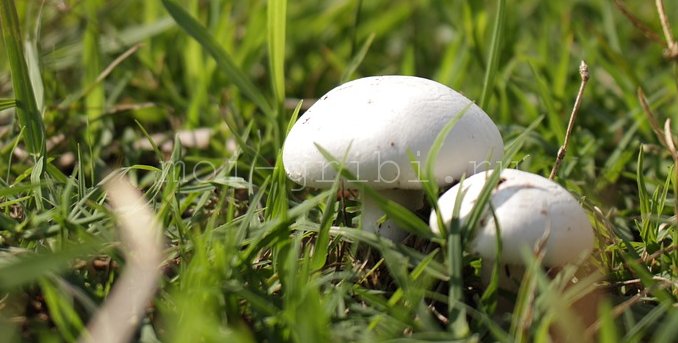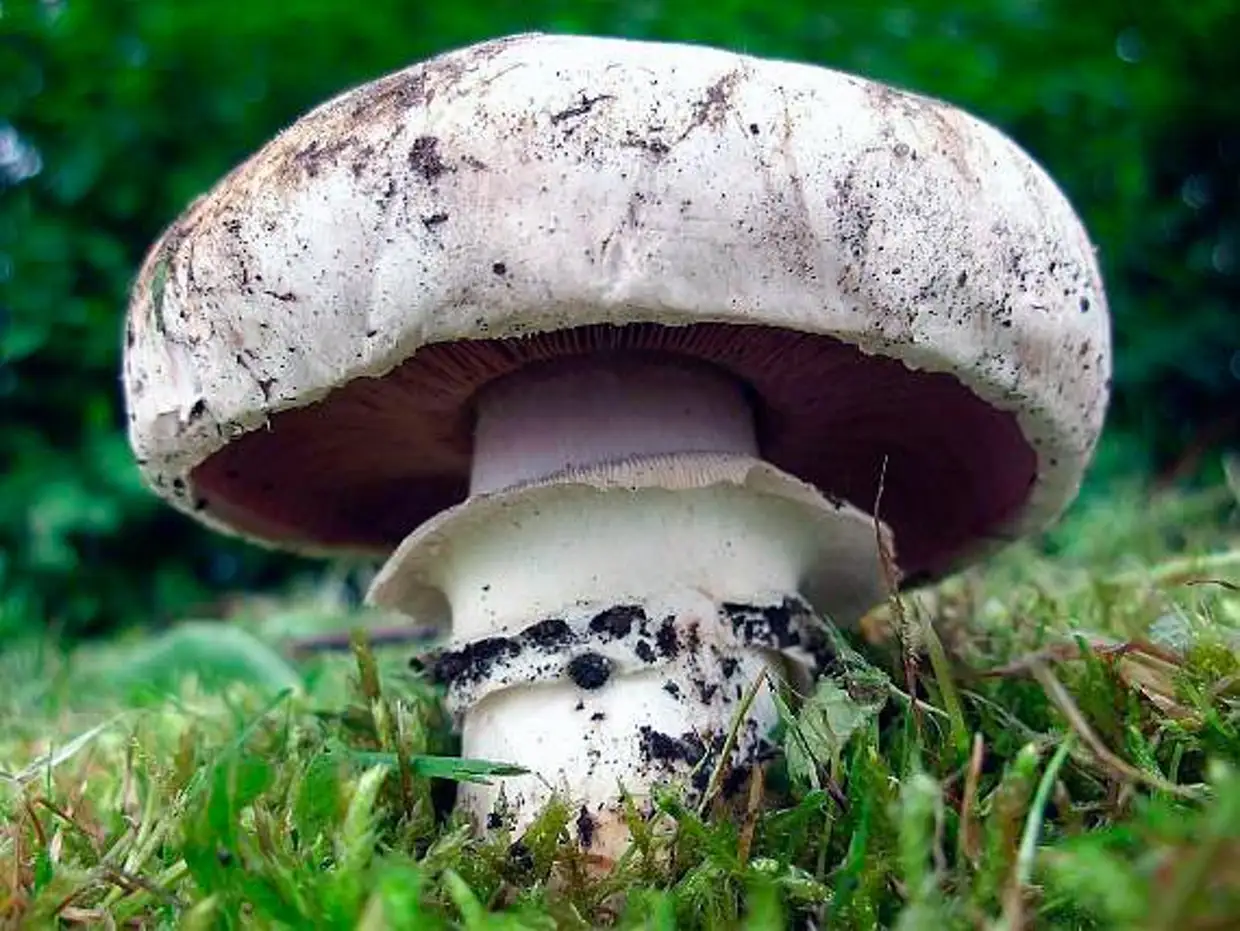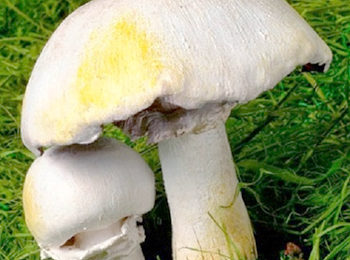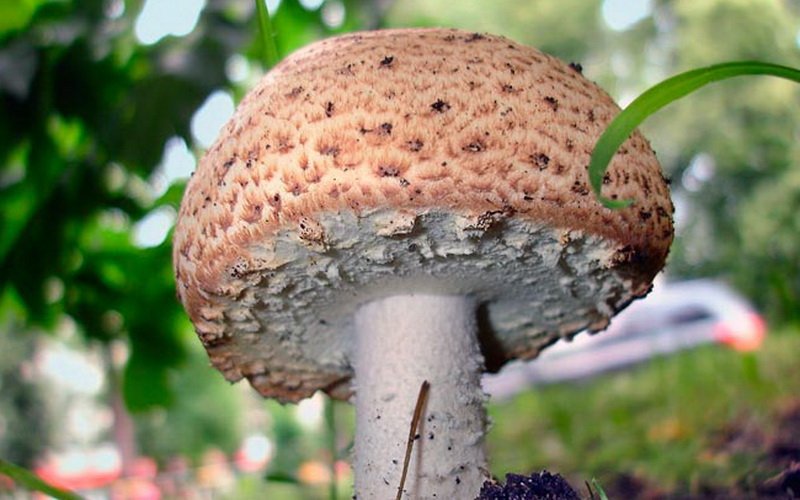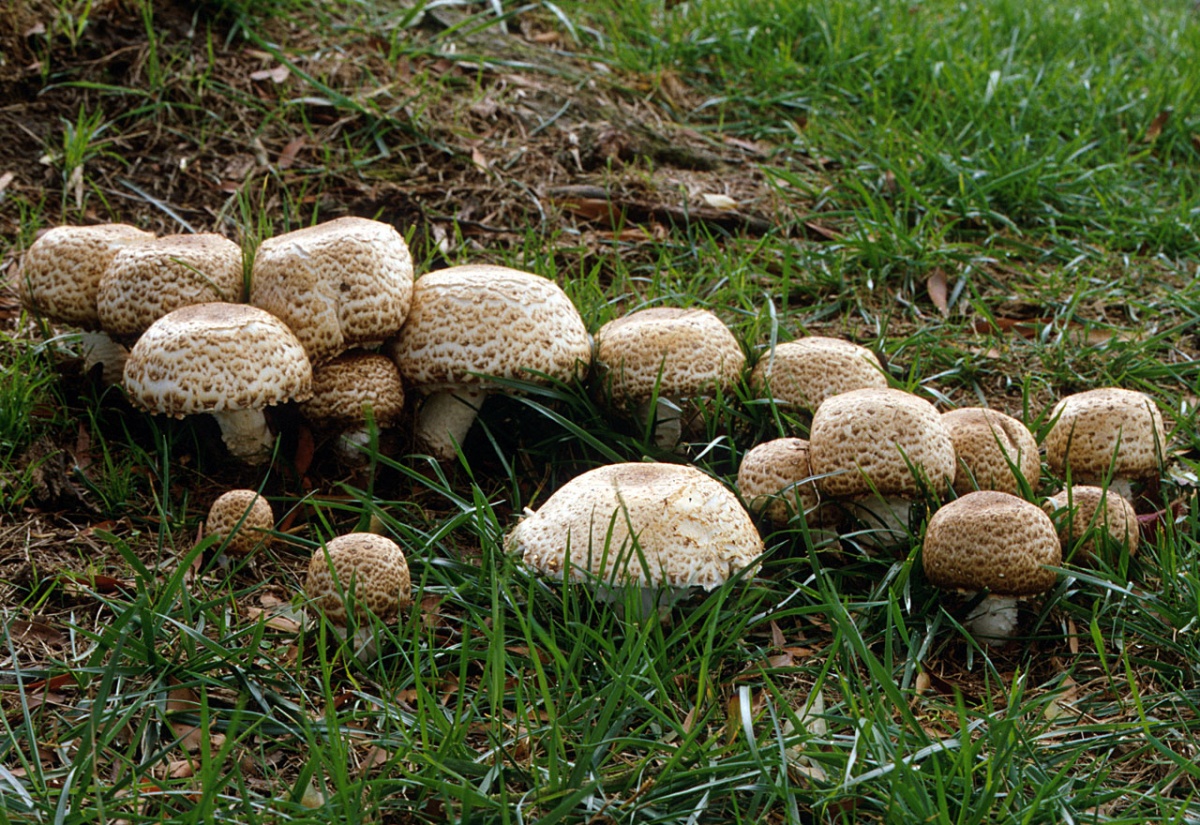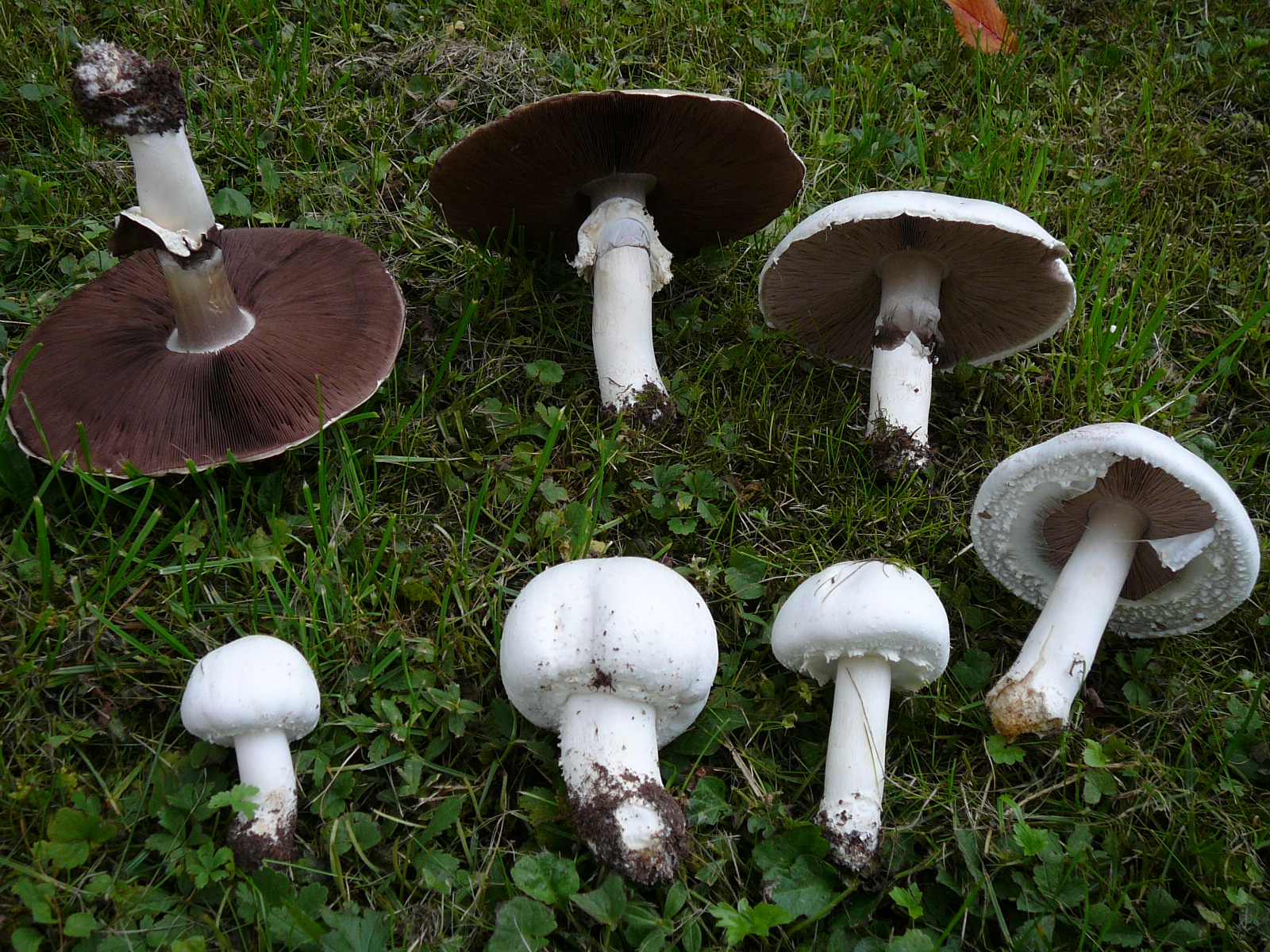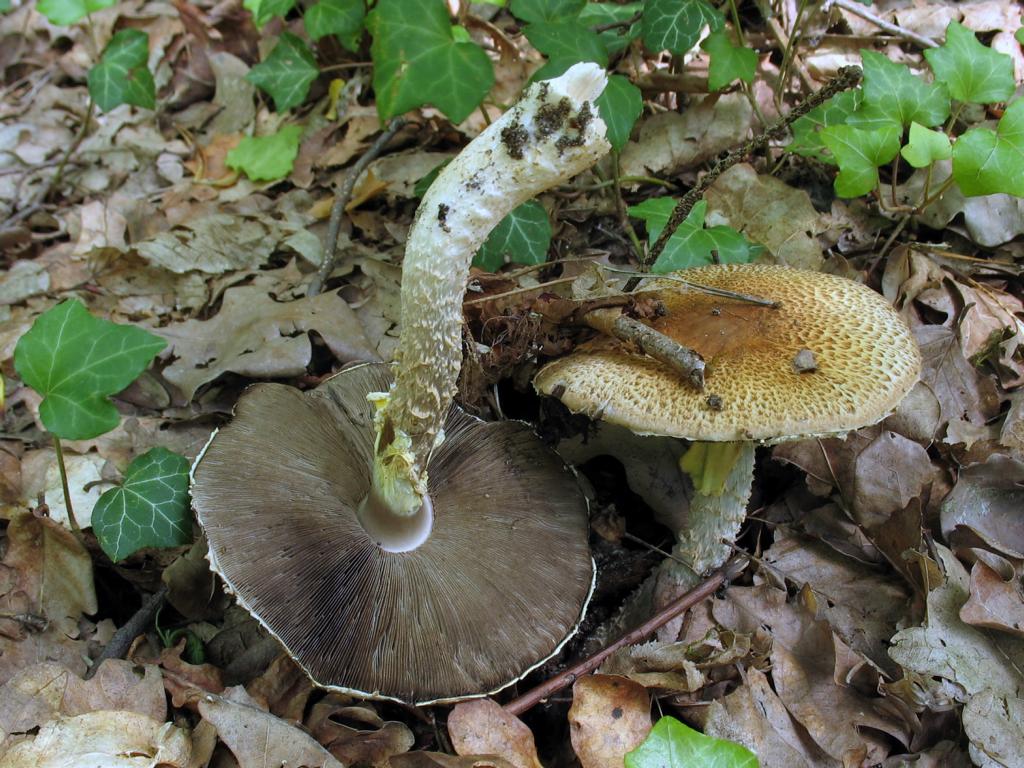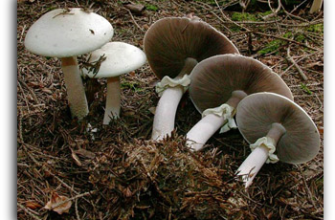Edible doubles
Champignon species are widespread throughout the globe, and in this genus, most good edible mushrooms, not just poisonous species.
Common champignon (Agaricus campestris) is a European species characterized by a white cap, a stockier body, unpainted surfaces and flesh, pink or brown gills, a grass habitat, and microscopic signs of 6.5–8.5 µm spores. Grows singly, in groups or in arcs and rings of fairies, in meadows, fields, lawns and grassy areas. Provided they are properly cooked and eaten in moderation (not as a daily meal!) Field mushrooms are healthy and delicious. It is unwise to collect food from the grassy slopes of busy roads, because the soil, vegetation and mushroom fruiting bodies from such places can be contaminated with toxins released from exhaust gases or from oil spills.
Field or horse champignon (Agaricus arvensis) is also an edible species that can easily be mistaken for yellow-skinned champignon. The specific epithet arvensis means "fields" or "meadows" - where the horse mushroom is most often found. The cap of Agaricus arvensis matures from 8 to 20 cm (rarely up to more than 30 cm). The surface is white, but yellowing with age, smooth or finely scaly, the cap is initially spherical and expands until it is flat or nearly flat. The flesh is thick and white and firm. The gills are pale pink at first, darkening, and then brown. The stem is up to 10 cm tall, the parallel stem is usually a small bulb at the base and a sturdy double ring with a toothed wheel on the underside.
When cut, the base of the stem of Agaricus arvensis does not turn bright yellow for a long time. This is a helpful visual distinction between this edible mushroom and the poisonous yellow-skinned champignon, Agaricus xanthodermus. This toxic toadstool changes color as soon as the edge of the cap is damaged.
Double-ringed champignon (Agaricus bitorquis) is an edible porcini mushroom of the genus Agaricus, which is similar to the poisonous yellow-skinned champignon. It gets its generic name from the habit of growing on sidewalks, surprisingly it can even grow through asphalt. Usually grows in groups of the same size, they are quite sturdy and relatively easy to identify. They do not turn yellow when cuts or abrasions appear, which eliminates the presence of a toxic yellow dye like Agaricus xanthodermus. The specific epithet bitorquis means "to have two collars," and refers to the two rings resulting from the separation of the annular space from both the top and the bottom of the leg.
Vyacheslav stepanov: mushrooms of the kaluga region - champignon august (agaricus augustus)
Common names
Common names Hat
Cap Hat: 8-15 (25) cm in diameter, at first, hemispherical, with a private veil covering the plates, then convex-prostrate, tuberous, with remnants of the veil along the edge, yellowish, brownish, with a darker middle, with dark brown scales , on the wounded places the plates turn yellow
Gills Plates: frequent, loose, whitish, then greyish-brownish, later black-brown with a lighter margin Spores
Spores Spore powder brown
Stem Leg: 10-15 cm long and 1-3 cm in diameter, cylindrical, widened towards the base, finely scaly, whitish or yellowish, with yellowish spots. Ring - simple, thin, yellowish pulp
Flesh Flesh: fleshy, dense, with aniseed scent, whitish, slightly yellowing on the cut Fruiting calendar
Calendar
according to long-term data of Yu. Semenov
based on Yuri Semenov’s long-term observations
Accepted designations / Legend
- the appearance of single mushrooms / seldom
- layers of poor fruiting / not much
- periods of stable, massive fruiting / a lot
The divisions on the time scale correspond to five days of the month
Ticks on the time axis correspond to the five-day weeks of the month Habitat
Habitat Habitat: from mid-August to October in coniferous forests, sometimes near anthills, in groups, rarely Edible
Edibility
Delicious edible mushroom (3 categories), the largest among champignons, used in the same way as the previous types
Mushroom Pictures On The Internet
Other photographs of this mushroom in the WEB
Remarks
Remarks Mentioned in reports
Links to the Informes
Dmitry Pesochinsky from 28.08.2003
Yuri Semenov dated 01.09.2002
How to distinguish a real champignon mushroom from a false one

You can buy it in almost any supermarket. However, some people prefer to gather mushrooms in their natural environment, engaging in "quiet hunting".
Therefore, it is very important to know how to distinguish false mushrooms from edible ones.
Botanical description
Champignons resemble small white balls in appearance. They have a dense cap structure that is slightly scaly. As the mushroom grows, it flattens and straightens out. The diameter sometimes reaches ten centimeters.
Their flesh is also dense, white, with a reddish or yellowish tinge. Has a pronounced mushroom aroma. The surface of the leg is flat and has a single or double layer ring.
These mushrooms can be found in nature almost anywhere in Europe, Asia, North America, etc. They usually prefer mountainous areas and low-lying forests, but they can also settle on the lawn near the house. Very often they are found in landfills and dung heaps, because they like well-fertilized soil.
Varieties of champignons
When going to the forest for mushrooms, you need to know the types of mushrooms, where they grow and at what time. In addition, it is advisable to know how the false mushrooms look outwardly. This will help distinguish them from the real ones.

In natural conditions, there are about a dozen species of this fungus. For example, in meadows and in the steppe, large-spore varieties of mushrooms or common champignons are usually found, they are also meadow.
In addition, there are also varieties that grow in forest areas. They grow around mid-July and can be found until mid-October. Found in deciduous or mixed forests. It is customary to refer to them:
- dark red champignon;
- coppice;
- August.
The benefits and harms of use
Snow-white mushrooms are a very useful product. They contain a large amount of folic acid, which the body needs for the production of red blood cells, proper metabolism, the work of the cardiovascular, nervous and digestive systems. Folic acid is very important for the proper functioning of the female reproductive system, it is involved in the formation of the placenta and is necessary for the proper development of the fetus. Also, these mushrooms contain vitamins and amino acids, which are very useful for women who are expecting a baby.
Champignon has few calories, but it has a high energy value. They are great for diet food. They are also high in protein and antioxidants and can be eaten even by diabetic patients. The composition of the product contains B vitamins even more than fresh vegetables. The high content of plant fibers makes dishes made from these mushrooms more satisfying and improves the body's metabolism. Because of these properties, nutritionists highly recommend including them in the diet of those who wish to lose weight, as well as strengthen muscle mass.
However, mushroom pickers should be aware that in the forests there are doubles of this mushroom - false champignons, which will not benefit the body, but only harm.
Differences between false and real mushrooms
Those who like to pick mushrooms in the forest should be careful. They may be in danger. The fact is that among the edible forest mushrooms there are also false ones. Among them:
- flat mushroom champignon;
- redhead;
- yellow-skinned.
It is very important to be able to distinguish them from edibles. They often grow in wooded areas, but sometimes they are found in meadows and swamps.
In appearance, they are very similar to the edible champignon. However, they have slight differences that make it possible to recognize a false mushroom.
If you compare them with edible mushrooms, then in edible mushrooms when pressed, the flesh turns pinkish or reddish. In addition, the inedible mushroom has a special specific and not very pleasant aroma. Its smell is similar to that of drugs, iodine or carbolic acid. If such a mushroom is immersed in boiling water, then the water will immediately acquire a yellow tint, and the smell will become stronger.
Two-ring champignon
| Group: | Lamellar |
|---|---|
| Plates: | Pink, light brown |
| Colour: | White to light brown |
| Info: | The pulp turns pink at the cut |
| Department: | Basidiomycota (Basidiomycetes) |
|---|---|
| Subdivision: | Agaricomycotina (Agaricomycetes) |
| Class: | Agaricomycetes (Agaricomycetes) |
| Subclass: | Agaricomycetidae |
| Order: | Agaricales (Agaric or Lamellar) |
| Family: | Agaricaceae (Champignon) |
| Genus: | Agaricus (Champignon) |
| View: | Agaricus bitorquis (Two-ring champignon) |
The edible mushroom belongs to the second food category. Another representative of the champignon family.
If many other species are quite similar to each other and can be easily confused, then two-ring champignon can be recognized almost instantly, as soon as you pick it up. The word "chunky" suits this champignon perfectly. Fat meat, on an uncharacteristically short leg and already with two rings on it.
This variety has one more advantage. This champignon can be found much more often practically in urban areas than in the forest. But it is worth remembering that champignons are a real sponge for heavy metals and other harmful derivatives of human life. Therefore, you need to be extremely careful when picking mushrooms in urban areas.
Hat

The skin is dry, slightly rough to the touch, with sparse few scales near the center of the cap. The structure is dense, the old mushroom is loose, fleshy. The cap is colored from white to light brown. The edges of the cap are folded inward. In size it reaches from 6 to 12 cm. The skin is separated from the pulp with difficulty.
Spore-bearing layer

The plates are often located, not adherent. By old age, the color changes to a deep brown. The spore powder is brown.
Leg
Reaches 10 cm in height and up to 4 cm in diameter. Dense, powerful, with firm flesh. There are two leathery rings on the leg. The leg is painted white, sometimes with a cream shade, color.
Pulp
With a weak mushroom aroma and a slightly pronounced pleasant sourish taste. At the site of a break or cut, it slowly changes color from white to pink.
Distribution and collection

The two-ring champignon is one of those mushrooms that prefer to settle near human habitation and are quite rare at any distance from it. This mushroom can easily be found along the edges of paths, in parks, gardens, pastures and pastures. It is found, as a rule, in groups of 3-7 specimens.

Similar species
From the dangerous double of all champignons, the two-ring champignon is distinguished by the absence of an egg-shaped depression at the base, a darker hymenophore, a powerful constitution and a double ring on the stem.
Almost all champignons that can be found in our latitudes are in one way or another similar to the two-ring champignon. It is quite easy to distinguish it from its fellows:
- First, the ratio of the length of the stem to the general constitution of the fungus is striking; it is disproportionately short.
- Secondly, no other mushroom species has a double ring anymore.
Use
The double-ring champignon does not require any pretreatment. It can be used both raw in a salad and fried, boiled, stewed. Champignons can also be harvested in salted or pickled form, but they are much tastier when fresh.
Interesting Facts

Two-ring champignon is an extremely strong mushroom. If the fruit body grows under the asphalt or even the pavement, it is capable of lifting and breaking through even such a powerful obstacle.
Due to the short legs, this type of champignon is not cultivated on an industrial scale, since this feature excludes the machine method of picking mushrooms.
Edible mushrooms. champignon august (agaricus augustus). photo, description, growth, category, use
Appears in August-September mainly in coniferous and mixed forests. It often grows near ant piles.
The cap is up to 15 cm in diameter, at first almost spherical, then it becomes semi-spread, pale yellow, silky. The skin of the cap cracks into small scales. The pulp is thick-fleshed, whitish, yellowing and turning brown at the break, the smell is anise.
The plates are free, in young ones they are gray, then pink-gray and, finally, chocolate-colored. The spore powder is brownish-violet.
The leg is 5-10 cm long, 1.5-2 cm thick, white, with a ring, turning brown at the fracture. The ring is white with yellowish flakes.
Champignon august is edible, of the third category. It is used boiled, fried, dried and pickled.
Growing champignons at home: instructions
Substrate for growing mushrooms
- 20-25% fresh, well-dried straw (preferably wheat or winter rye)
- 75-80% horse (ideally) or cow dung.
Compost for growing mushrooms: stages of preparation.
- For 1 sq. m. of the plot, which is set aside for a mushroom plantation, requires 30 kg of pre-moistened straw and 15 kg of manure.
- Each component is laid in several layers (3-4 layers) and a substrate is formed. The straw is moistened and fertilized with a dung "layer".
- After a week, 6-7 kg of gypsum (or alabaster) is added to the substrate, and all layers are thoroughly mixed.
- Re-stirring should be done after 4 days and, if necessary, re-moisten the mixture. Then 2 kg of superphosphate and 5 kg of crushed chalk are added. With a time interval of 4 days, there are two more mixing of the components.
- After 3-4 weeks from the moment of formation, the compost for growing mushrooms is considered ready.
The most famous champignon is ordinary
We are all accustomed to buying the considered mushroom fruits in supermarkets or in the markets - white balls with edges curved to the leg, resemble a perfect ball and are pleasant to the touch. The light skin of the young representative resembles velvet. With age, the delicacy begins to open up and increases several times in size, the color darkens. This species grows on a very fertile substrate, most often it is soil rich in humus, or meadows naturally fertilized with the manure of herbivorous livestock.
The ripening period of the "ordinary" species is from the end of May to the end of October (November - for warm regions). The crop can be harvested several dozen times over the entire season. The mushroom tastes good and is used to prepare various dishes, from salads to complex sauces or baked goods.
Photo
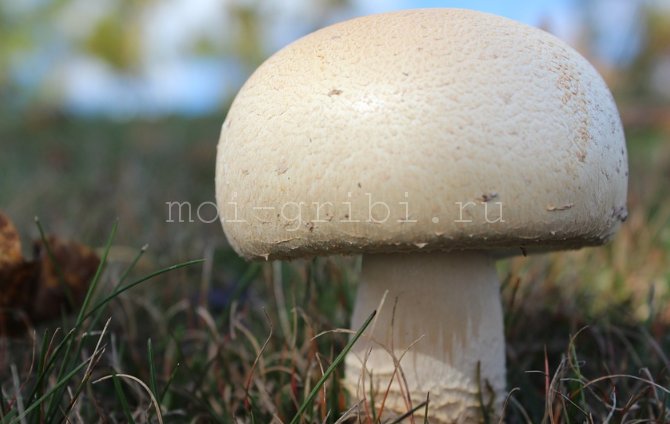
Ordinary.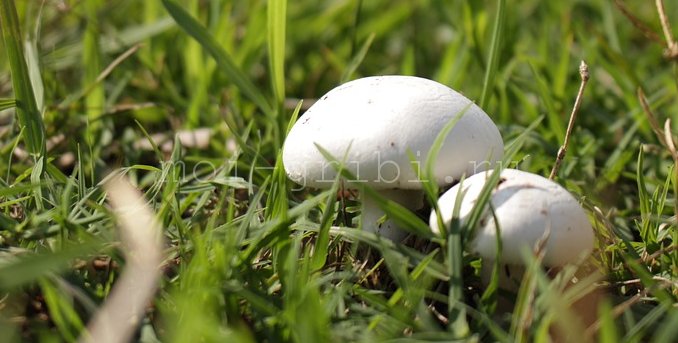
Agaricus campestris.
Here we will say a few words about the forest representative of the family. It resembles a bell on a high leg. The hat is covered with dark scales. Safe for humans.
Forest mushroom
Forest mushroom (lat.Agaricus silvaticus)
Forest mushroom (lat. Agaricus silvaticus)
Popularly referred to as a wolf mushroom. Also known as blagushka and cap.
It is less popular with mushroom pickers because of its reddening pulp. It can be eaten in all forms, even raw. It got its name because of its "residence". It has a pleasant smell and excellent taste. It grows mainly in spruce and coniferous forests. Less common in mixed forests. It prefers to grow near anthills and, in frequent cases, at their very top.
The leg is straight or curved. In young mushrooms, it is whole, becoming hollow over time. The thickening in the lower part of the leg becomes thin closer to the cap. Height 5-10 cm. The color of the leg is dirty gray. It has a thin ring at the top. During the ripening process, the ring disappears.
The cap of the young forest mushroom is ovate-bell-shaped, the color varies from light gray to brown-brown in maturity. At this age, the cap takes on a prostrate shape. The size of the cap is 5-10 cm, often up to 15. The cap is covered with large brown scales. The pulp, unlike most champignon mushrooms, is rather thin and light. When cut, it turns red.
Forest mushroom photo
Forest mushroom (lat.Agaricus silvaticus) Forest mushroom (lat.Agaricus silvaticus) Forest mushroom (lat.Agaricus silvaticus)
Poisonous types of champignons
Among wild mushroom species, poisonous varieties are quite common, the consumption of which can have serious negative consequences for health.
That is why it is very important to know what a poisonous specimen looks like and what characteristic distinctive features it has.
In addition to the poisonous representatives of the champignon family, there are a number of mushrooms that, in appearance, very much resemble the described fruiting bodies, but are not their "relatives", the so-called doubles or false ones. Most of all, inedible specimens are similar to the pale toadstool or white fly agaric.
Important! Heat treatment of poisonous fruit bodies does not deprive them of toxicity.
You can recognize a poisonous mushroom by some signs:
- The color of the pulp at the cut. In inedible representatives, the color of the pulp after breaking or cutting it remains the same, does not oxidize, unlike high-quality champignons.
- The color of the plates. An adult edible champignon changes color to a darker color of the plates, which are located on the inside of the cap. In poisonous fruit bodies, the color of the plates does not change during the entire period of ripening.
- Root pouch. One of the most important differences between toxic mushrooms is the presence of a sac, that is, a small swelling at the root. The bridesmaids do not have it.
- Aroma. Edible champignons give off a pleasant mushroom, almond or anise aroma, in contrast to the poisonous ones, which often smell like medicines.
Champignons are not only one of the most common and accessible types of mushrooms, but also one of the most useful. They contain a large amount of protein, so they can become a full-fledged substitute for meat. However, going out on a "quiet hunt" you need to remember that there are inedible varieties and poisonous counterparts, the use of which can lead to detrimental consequences for human health.
It looks like a field fellow, only the leg is yellowish-orange. The damaged skin or pulp also acquires a yellow tint, exudes a nasty smell, reminiscent of carbolic acid.
He's ginger
It has a medium-sized head, widening at the edges, the surface is covered with small scales. If you press on the pulp with your fingernail, it instantly turns yellow. The stem is thin, often empty inside, bordered by a small fibrous rim. On the inner side of the cap there are thin, frequent plates of light shades (can be beige or pink); during aging, the plates darken and become brown-brown.
Other names are carbolic, flat, scaly. By the appearance of the fruit, it is easy to determine which mushroom is in front of you - a gray cap with a darkened core also exudes the smell of carbolic acid. Folk healers and experienced old women argue that this variety is suitable for eating if the deceptive forest gift is thermally processed at least five times, but it is better not to risk your own health.
We have considered the most common types of champignons, since they are most often found by numerous gatherers. Do not be afraid to go for the forest harvest, improve your knowledge and remember the golden rule of any forester - “Doubt? Do not take".
City mushroom (two-ring)

Two-ring view of champignons in the photo

Two-ring champignon in the photo
It looks like a poisonous yellow-skinned champignon (Agaricus xanhodermus), the flesh of which turns pink when cut and smells like carbolic.
Surprisingly, this member of the family is found even in busy cities, on asphalt terrain. The plant has a thick, fleshy leg, pink plates and is considered suitable for food, but it is not recommended to eat its fruits - the mushroom quickly absorbs all chemicals and toxic substances from the atmosphere (it can be harmful to health), and in busy cities it is difficult to speak about good ecology.
 Found him in the city, in the yard.
Found him in the city, in the yard.
Hunting and fishing in the Tver region
Hat: 5-12 cm in diameter, from hemispherical in young mushrooms to half-open, flattened at the top and with rolled edges, at maturity; develops mainly underground or under asphalt, appearing on the surface only in old age. For this reason, the flat caps of the two-ring mushroom are often covered with a camouflage mound of earth. The color of the caps is white or grayish, the flesh is thick, light, turns pink at the break, with a pleasant "champignon" smell and taste.
Plates: Loose, frequent, narrow, in young mushrooms, light cream, almost white, gradually acquire pink, red-brown, dark brown and almost black color with age. In the early stages of development, the mushroom plates are reliably protected by a thick double ring.
Spore powder: Dark brown.
Leg: Thick, short (3-5 cm in height, 2-4 cm in width), solid or slightly executed, the color of the cap. The remnants of a private bedspread are clearly visible - a double thick gray-white ring, in mature mushrooms it is dark in the upper part from raining spores.
Distribution: Agaricus bitorquis is a widespread mushroom, found in large, but usually loose, scattered groups from mid-May to late September in gardens, vegetable gardens, parks, preferring richly fertilized fertile soil. A common mushroom for cities in central Russia. The two-ring champignon develops mainly under the soil, which makes it inconspicuous, but once you have explored the place of growth, you can return to it several times per season and, picking out the characteristic tubercles, release round, dense, heavy champignons from the soil. Quite often the double-peeled champignon is not satisfied with its usual growing areas and breaks the asphalt, sprouting under the sidewalks and bike paths.
Similar species: There are quite a few similar light champignons. Agaricus bitorquis is easily distinguished from closely related species by its characteristic double ring, short thick stem and flat, stool-like cap.
Edible: Refers to first-class edible multi-purpose mushrooms; It should be noted that mushrooms should not be harvested in cities and on the roadsides even more than, say, mycorrhizal mushrooms.
Author's notes: For me, two-ring champignon is a mushroom from a happy childhood. I don't remember at all how it happened and why they completely trusted me at home in terms of mushrooms, but already from the second grade I did not return from school without prey. The whole September was devoted to mushrooms - leaving school, I purposefully walked around all the courtyards and squares, bringing a whole package of a variety of mushrooms, among which were white and gray dung beetles, and a variety of raincoats, and a few, from which even more valuable mushrooms and, of course , rare city mushrooms. Often my father joined my searches, but as a rule, my parents played only a culinary role in this matter. Again, I don't remember what the full confidence in my mushroom skills was based on, but everything I brought home went into food - I know for sure. I myself would probably not have been able to trust my child so much, but my parents somehow managed, and well - gambling, filled with some difficult to describe meaning, walks through the courtyards became for me one of the brightest impressions of this period of my life. It's a pity that September is such a short month, and then the mushrooms leave for a long time from where they appear in spring or autumn - into oblivion ...
Common champignon

Common champignon (lat.Agaricus campestris)
The people also call him the real (214) or the cottage. This type of champignon does not emit juice, it has a pleasant smell. It can be eaten in any form: fried, boiled, pickled. Does not lose its taste when dried or salted. Champignon real grows, as a rule, in large groups on well-fertilized land, in meadows rich in humus, near livestock farms, in vegetable gardens near housing. Common champignon, begins to bear fruit in spring and ends in late autumn.
Real champignon is one of the largest representatives of champignons.
The cap of the present champignon has the shape of a convex semicircle (at a young age), in adulthood it is flat. Has a white or grayish skin that can be easily removed. The surface is dry, white or brown. In mature mushrooms, the cap can reach 12-15 cm in diameter. The pulp is dense, thick, white, turning pink at the break.
As the mushrooms ripen, the plates change their color from white, with age they become dark brown, and in the old ones - black.
Large-spore champignon
Large-spore champignon (lat.Agaricus macrosporus)
Large-spore champignon (lat.Agaricus macrosporus)
This is a fairly common mushroom. The habitats of this type of champignon are quite diverse. It can be found in almost all European countries. It also grows in England, Asia, the republics of the Caucasus. Large-spore champignon grows mainly on meadow soils rich in organic matter. The mushroom is large.
The hat is convex, white. At a young age, fibrous, eventually cracks into wide plates or scales. The edges of the cap become velvety as the mushroom matures. Reaches 25 cm in diameter. At a break it is white, after a short time it turns red.
The plates of the large-spore champignon are free. They are located very often. At an early age, pale pink or gray. Over time, the plates turn brown.
The leg is full, dense. It reaches a height of 6-10 cm. At the base it is thickened. It can be white or off-white. Fusiform, sometimes covered with flakes. It bears a single thick ring, which is covered with scales on the underside. The pulp is white, slightly reddens over time. An adult mushroom has the smell of almonds on the cut, turning into the smell of ammonia.
The large-spore champignon in its nutritional value belongs to the mushrooms of the first category, which indicates its beneficial properties for the healing and treatment of our body. Possesses good taste.
Curve champignon
Curve champignon (lat.Agaricus abruptibulbus)
Champignon distinctly nodule (lat. Agaricus abruptibulbus)
Other names for this mushroom: almond roadside, almond champignon, white champignon, cultivated champignon, champignon distinctly nodule.
The habitats of the crooked champignon are coniferous and spruce forests. Likes to settle on spruce bedding. Appears quite early, in June. And it appears in small groups or lonely individuals. Closer to autumn, the curve champignon "unites" into more numerous families, numbering 10-15, and sometimes up to 30 pieces.
The hat reaches 8-12 cm in diameter (sometimes mushrooms up to 20 cm are found). At an early age, it has a rounded, ovoid, closed shape, with edges curved inward. Pure white. Over time, the cap opens and becomes open, changing its color to light pink, sometimes with a purple tint. Has a silky surface. The pulp is not fleshy, thin. Slightly yellow when pressed.
Curved champignon plates are frequent, free, not adhered to the stem. At a young age, white. Over time, the color changes to reddish-brown, and in adulthood it becomes black-brown.
The leg is quite large. It reaches 8-12cm in length. Cylindrical shape. At the base, the leg expands and tapers closer to the cap. It has a characteristic bend at the base. After bending, the leg is hollow. In its upper part, the leg has a wide, wavy, hanging ring. The ring is single-layer, thin.Slightly scaly on the inside, smooth on the outside. The flesh at the stem is fibrous, dense and fleshy. White when cut, turns slightly yellow over time.
According to its nutritional value, the curve champignon belongs to the third category. Delicious, edible mushroom. In cooking, it can be used in first and second courses. Also has excellent taste when pickling and pickling.
You can collect it from June to October.
Champignon august. - edible mushrooms - description of mushrooms - mushroom dishes
12.06.2010, 04:29
Champignon august is one of the varieties of champignon mushrooms. Popularly called the spikelet champignon. This is a typical forest mushroom. Experienced mushroom pickers consider this type of mushroom the most beautiful and delicious. It is also used for medicines in folk medicine; fresh and dried mushroom caps are used for these purposes.
This mushroom has a rather large cap, reaching 25 centimeters in diameter. In youth, it is somewhat spherical, covering the plates, with growth it opens, becoming convexly spread. The color of the cap varies from pale yellow to dark orange, dark brown, with a bump in the center that is more saturated in color; the surface is silky, cracking forms small orange-brown scales. Along the edge of the cap, the remains of a blanket are often visible, which covers the plates in an immature mushroom. The plates themselves are free, often located; in young mushrooms, they have a creamy hue, which becomes light brown (chocolate) with age. Brown spore powder. The leg is long, from 5 to 15 centimeters in length, 1-3 centimeters in diameter; cylindrical, dense in young mushrooms, has a thickening in the lower part, on top there is a large, hanging, folded white ring, smooth, with yellowish flakes on the lower part. The surface of the leg is or yellowish, covered with scales, slightly yellow in the wounded areas.
It grows from early August to October, preferring coniferous forests (especially spruce) and organic-rich soil, grows in parks, often near anthills. It is rare, but at the same time forms large groups.
Champignon Augustus is an easily recognizable edible type of mushroom. It can only be confused with red champignon, which is never as big as the August one, and has a strong, unpleasant smell of carbolic acid or ink. When cut, the red champignon quickly becomes yellow at the base of the stem; the mushroom is toxic, poisonous.
Champignon August is a very tasty mushroom. Has a dense, fleshy pulp with a pleasant aroma of anise. Has received wide culinary use (like all edible champignons), can be used both in the form and after culinary processing. Suitable for pickling, salting, drying, fried and boiled.







